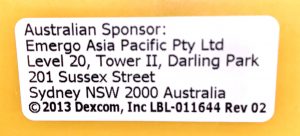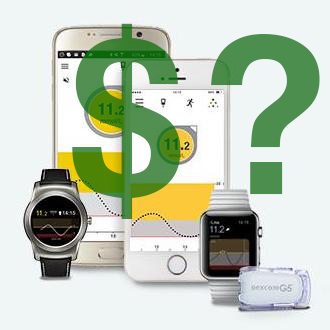There has been a lot of excitement in Australia about the discovery of a cheaper way of accessing the Dexcom G5 CGM. Read that article if you haven’t already. Many people have discovered that yes they can afford to use this life-changing technology.
Incidentally, the Medtronic CGM transmitters and sensors have also been available via the pharmacies, but apparently not at a substantial discount from Medtronic’s subscription pricing model. They are cheaper than the Medtronic per-box pricing though.
Unfortunately even these cheaper prices are still too expensive for many people. Having and surviving diabetes is not a low-cost proposition, and it can be a struggle.
Of course many people have been asking….
Why has it been more expensive?
To recap, AMSL (the Australian Dexcom distributor) has said there are two ways of accessing the G5 supplies:
- Purchase sensors ($370 per box of 4) and transmitters ($540 each) direct from AMSL.
- Get them provided for free by the government (through the NDSS CGM subsidy scheme which is currently only available to a minority of people with diabetes).
Whichever way you get the equipment, AMSL are the organisation who provides technical support (including replacements for any failures). I must say I’ve always found their support great (both for CGM and for the Animas pumps I used to use).
However, as we now know we can also source the sensors and transmitters through pharmacies, often at significantly lower cost than through AMSL. So how does this work?
A lay view of the NDSS supply chain
NDSS products are supplied through NDSS Access Points (pharmacies). This includes syringes, needles, BG test strips, insulin pump consumables, and CGM.
My understanding is that when someone orders NDSS goods, the pharmacy:
- buys them through their wholesalers (see my previous comments about some inconsistencies with this supply chain),
- sells them to the customer at the NDSS price (some but not all of the subsidised prices are $0: CGM and syringes/needles are examples), and
- invoices NDSS for the cost of the goods.
 Note that it seems that AMSL are the source providing the Dexcom equipment to the wholesalers (as the exclusive Australian distributor they would have to be). The boxes provided via the pharmacies have the same markings as those provided directly from AMSL.
Note that it seems that AMSL are the source providing the Dexcom equipment to the wholesalers (as the exclusive Australian distributor they would have to be). The boxes provided via the pharmacies have the same markings as those provided directly from AMSL.
What seems to be happening with the purchase of CGM supplies via pharmacies is that the pharmacy is basically just cutting out step 3 (invoicing the customer rather than NDSS).
I’ve been hearing of people purchasing boxes of sensors for between $250 and $270. Note that this is not just one pharmacy chain, and not just one pharmacy wholesaler. It’s been a mixed bag across the country. Some pharmacies have wanted to charge closer to $500.
I bought a box for $258.39, and was quoted $273 for a G5 transmitter. These are presumably not the prices that AMSL charges the wholesaler, and it does seem reasonable to assume that the wholesale price was lower. It might actually be an even-lower figure like $215, but for simplicity I’ll just use the figure of $250. Compare $250 for a box of sensors with $370 when bought through AMSL.
From the above we should be able to draw some conclusions:
- As AMSL provided the equipment, we can expect they will continue to provide technical support. Just as they do for NDSS-supplied CGMs.
- AMSL would seem to have been making an extra $120 on each box of sensors sold directly.
Of course, they don’t charge shipping on direct orders so some margin was to be expected. But a 50% markup is quite significant. - Some folks at AMSL are presumably upset about losing that immediate profit from their short-term financial forecasts.
I’ve previously mentioned that more sales at the lower price could eventually make up for the higher profit at lower numbers. But I can’t model where the break-even point is, and a 50% markup does seem a lot to make up.
Legal action?
Early on when AMSL was asked if they supply the pharmacy warehouses, they said that they can’t answer as “it’s a legal matter”. What? This week I’ve been getting told by multiple sources that AMSL have engaged lawyers regarding this CGM pricing.
What would these lawyers be doing? And why?
NDSS CGM subsidy expansion
When AMSL got the Dexcom CGM included in the NDSS subsidy scheme, they presumably had to negotiate a price with the government. It now seems that we’re getting some visibility on what that price was.
There has been a lot of lobbying over the last years to expand the CGM subsidy (the tag #CGM4all is quite popular). We had an eligibility expansion earlier this year and more people are getting to access CGM via NDSS. Everyone is of course hoping for further expansion as (especially for those of us who live with diabetes) increased access is the bottom line in this.
When the NDSS numbers increase, do we expect that AMSL gets to renegotiate a higher Dexcom price? I would be very surprised by that: I would expect that as the subsidy is expanded that AMSL was planning to simply make more sales through the NDSS channel and would have taken this into account when negotiating the NDSS price.
Given the higher price, I wonder what service AMSL provides to direct customers that they don’t provide to NDSS customers.
So why should AMSL be upset about more sales?
Discussion
Maybe my analysis above is flawed in some way, but hopefully I’ve been clear about the logical progression.
Unless the pharmacy chain has somehow been making a loss on these items (“in order to get our business” on something they don’t advertise?) it seems that the actual cost of a box of sensors is less than $250.
That’s not production cost: that’s a price that AMSL is willing to sell them at.
What would happen if pharmacies were somehow prevented from selling the CGM gear to us?
Consumers would be very unhappy about being told they have to pay an extra 50% every month for technology that helps them cope with life with diabetes (and some related conditions).
I have heard a lot of people mention talking to the ACCC for example.
What will happen next?
Hopefully access to this life-changing technology will continue to improve, and not take a huge step backwards.
Remember that measures like Time in Range are becoming recognised as more significant health indicators than HbA1c. But you can’t measure TIR without CGM!
Hopefully we’ll also see options like Dexcom G6 get introduced into Australia soon.
UPDATE: See the next article on this topic.


Certainly an interesting space at the moment! Interesting to see what will come out of all this!
Thank you so very much for this write up David. I am thinking very positively about purchasing the dexcom5 transmitter and sensors from the pharmacy chain as it is more affordable. Currently I’m on Freestyle Libre as I haven’t been able to afford the approx $7,000.00 a year cost of dexcom cgms. Thank you again for the updates and hopefully the legal system is in our favour?
Thank you for your thoughts. Your analysis is appreciated, thanks for sharing your knowledge.
David thanks for alerting us to possible action by a AMSL in response to folks purchasing sensors direct from pharmacies. Hopefully the Competition and Consumer Act 2010 Anti-Competitive provisions (Part IV) have got this covered. Will be interesting to see what comes. Kim (Regulatory Scientist working in grocery/food/pharma – happy to chat further w you).
Does sound like price fixing to me. Hopefully AMSL’s lawyers will advise them that and that it is illegal.
Similar price advantages in the US, such as through retailer Costco, seem to cause no issues and happen at Dexcom’s discretion.
I’d rather think about bypassing the issue for those without coverage, because #wearenotwaiting, right?
It should be fairly easy to manufacture compatible or knock-off transmitters. I have seen the innards, and think even the program could be hijacked.
I wonder about protections, if they are like patent or more like pharmaceutical and expire. Maybe expiration is why they are phasing out the g4/5 sensors.
I want to hear from anyone who knows!